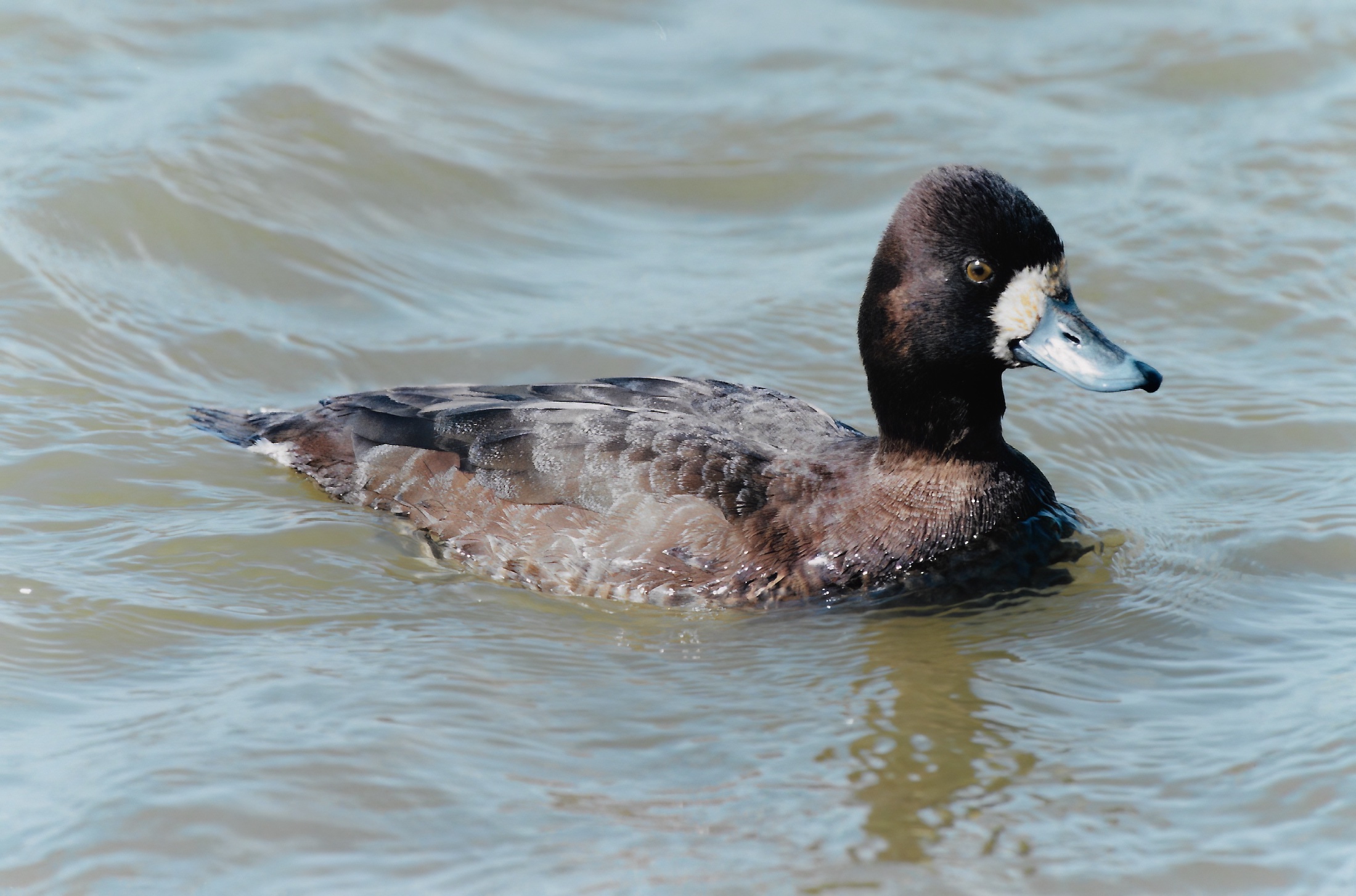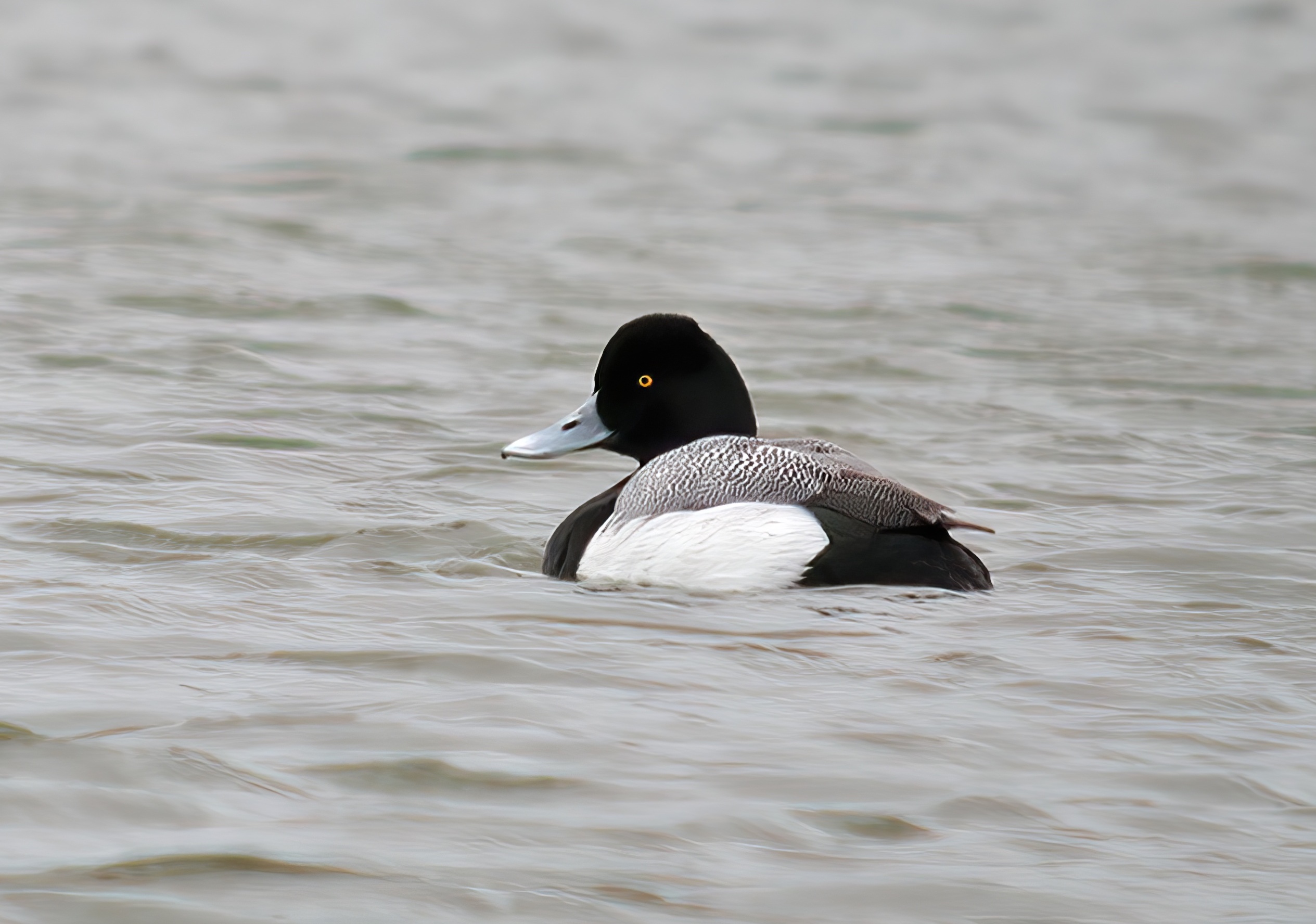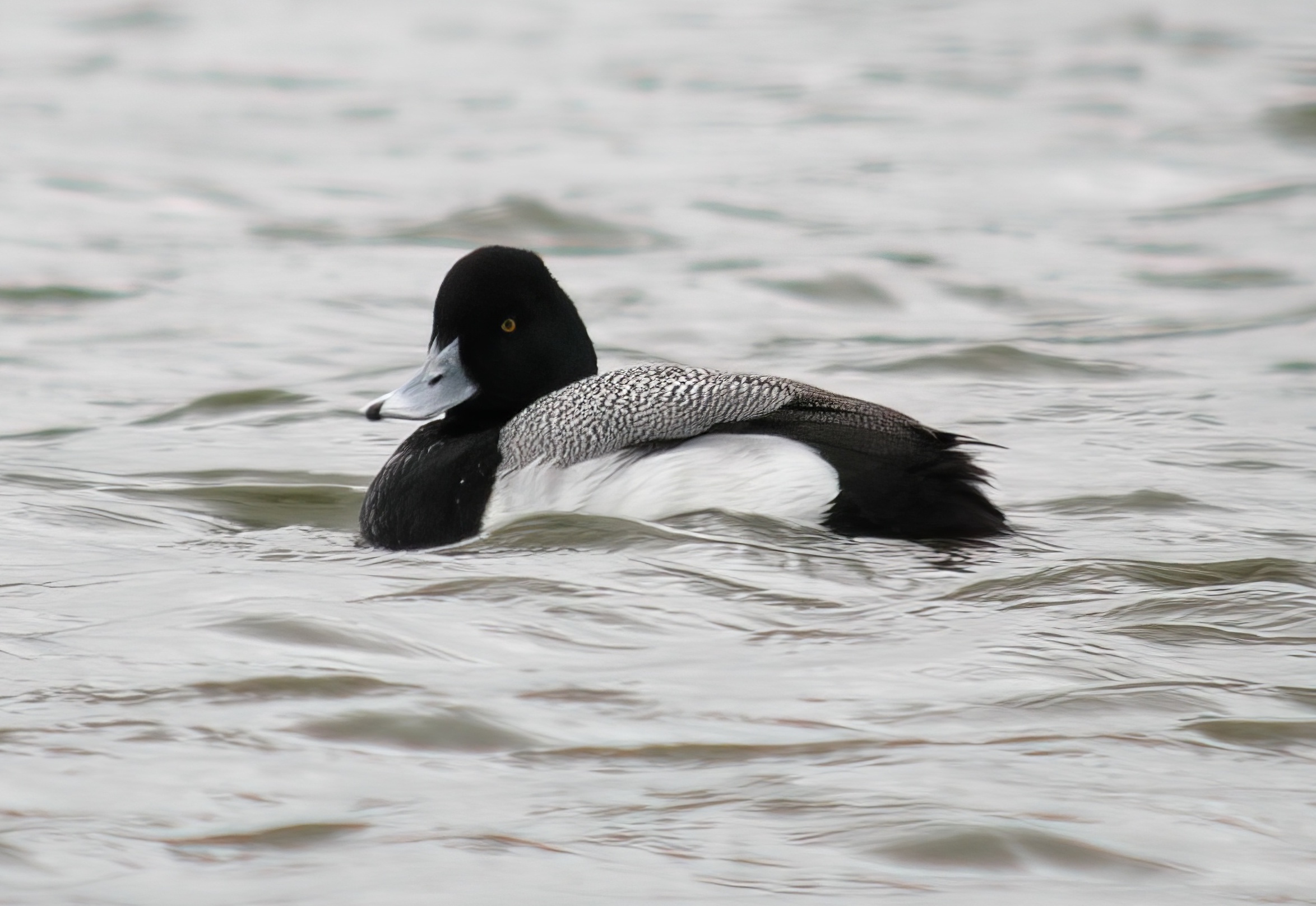Lesser Scaup Aythya affinis. BBRC
Vagrant. North America (Returned to BBRC status from January 1st 2020).



Lesser Scaup: left, 2CY female, at Cleethorpes CP, April 5th 1999 (Iain Leach), centre/right, adult male, at Water's Edge CP April 20th 2004 (Graham Catley).
Not recorded in Britain until 1987, it was another eight years before one was found in Lincolnshire, a 2CY male at Barton upon Humber, in February 1995. Most of the Humber duck flock were flighting onto one of the east side pits at Barton to bathe and roost in the late afternoons. On February 13th there were 270 Pochard, Aythya ferina, and two drake Greater Scaup, Aythya marila, and on Barrow Mere 300 Pochard, and a few Goldeneye, Bucephala clangula, Ruddy Duck, Oxyura jamaicensis and two more Greater Scaup together with a rather odd looking duck resembling a Tufted Duck, but fast asleep. It looked reminiscent of a Lesser Scaup, A. collaris, and soon after when it had awoken its identity was confirmed. Aged as a 2CY bird due to the extensive area of brown feathering in the plumage. There have been five others since, three males, one female, the most recent being an adult male at Chapel Pit LWT reserve, later Manby Flashes in April-May 2021.
Hybrids between male Tufted Duck and female Pochard closely resemble male Lesser Scaup and this remains the main identification pitfall for acceptance of this species. Such 'Lesser Scaup type' hybrids have been reported a few times in the County, for example at Covenham Reservoir from January 12th-February 28th 1985, one or two in the Deeping St. James and Baston/Langtoft pits area in the five winters of 1990, 1991/92, 1992/93, 1993/94 and 1994/95, one at Toft Newton Reservoir on April 29th April and most recently one at Baston and Langtoft pits on February 27th 2009. The geographic spread of sightings across the UK has indicated that almost any eutrophic lake or pond with a few other Aythya ducks will always be worth a second look for those intent on finding their own Lesser Scaup.
Once the unique features identifying this “Yankee duck” became more widely known the number of British records gradually increased through the 1990s and 2000s with a peak of 27 in 2007 and it was recorded every year between 1992-2020. After an absence 2015-2019, it was returned to BBRC consideration in 2020. Lesser Scaup breeds from Central Alaska through Canada to Hudson Bay, and south to Washington and South Dakota. Isolated populations also occur East of the Great Lakes. The species winters along both coastlines of the USA, in the east from New Jersey to Mexico, the West Indies, and Central America to Northern Colombia.
| Site | First date | Last date | Count | Notes |
| Barton Pits and New Holland | 13/02/1995 | 16/02/1995 | 1 | 2CY male |
| Torksey | 14/05/1998 | 1 | Male, flew in from Rampton Lakes (Notts) | |
| Cleethorpes CP | 05/04/1999 | 16/04/1999 | 1 | 2CY female |
| Water's Edge CP | 28/04/2004 | 30/04/2004 | 1 | Male |
| Freiston Shore | 19/03/2013 | 14/04/2013 | 1 | 2CY male |
| Chapel Pit LWT Reserve | 29/04/2021 | 1 | Adult male | |
| Manby Flashes | 24/05/2021 | 1 | Adult male, presumed same as Chapel Pit bird | |
| Seaview Washland, Saltfleetby-Theddlethorpe Dunes NNR | 16/05/2023 | 17/05/2023 | 1 | Adult male |
Finder's Report: Lesser Scaup at Barton/New Holland, February 13-16th, 1995, first county record.
by Graham Catley.
Circumstances
Monday February 13th dawned wet and windy, a good day for arguing with a computer, but by 16.00 I had cracked and as the weather was brightening a quick walk around the pits seemed a good idea. As the shooting season had drawn to a close most of the Humber duck flock were flighting onto one of the east side pits to bathe and roost in the late afternoons. A quick check of the new diggings pit revealed 270 Pochard and a couple of drake Scaup. Passing to the other pit, Barrow Mere, turned up another 300 Pochard, a few Goldeneye and Ruddy Ducks, another couple of Scaup and an odd-looking, Tufted-sized duck, fast asleep, which was sure to be a hybrid! It looked somewhat like a Lesser Scaup but at 200 yards I was very cautious of jumping to a conclusion. When it eventually put its head up, I was sure the bill was narrower than that of a Scaup and it looked as if only the nail was black. The flanks were not white, and the mantle was darker grey than that of a 1st-winter Scaup next to it. The head had a small bump at the rear, and it looked high-crowned, but as it came a bit closer I was still struggling to convince myself that it was a real bird rather than some very subtle hybrid. Eventually I decided I needed to get closer, and at the risk of putting everything up, I crept down the railway line and into the hawthorns by the side of the pit. From 100yds in reasonable light with a 30x 'scope I could now see the bill pattern clearly, the exact shape of the black bars on the mantle and scapulars and vermiculation on the flanks. I was convinced that it was a Lesser Scaup but though I watched until it grew dark, the bird refused to show it's wing pattern. The following morning, I was back before the sun came up; the duck was still present and eventually flapped it's wings and preened, confirming it's identification beyond doubt. I watched until it flew off with a small flock of Tufted Duck to feed on the Humber, then put the word out. The bird was seen both at Barton and New Holland until 16th.
Description
General appearance
Overall, an obvious scaup due to the pale flanks and grey mantle/back, but very different to Scaup in shape, size and jizz. Obviously smaller than Scaup alongside and more compact, with a squatter body and much more angular head, with peaked crown. Usually held head and neck hunched rather like Tufted Duck, but when alert would stretch neck up to give a long thin-necked profile.
Head pattern
Steep forecrown, crown flattened to an obvious bump at the rear, nape curved down evenly to mantle. Face-on the high central crown and bulbous cheeks were obvious. Head all glossy black with a distinct purple gloss in sunlight, eye yellow, duller than 1st-winter male Scaup and male Tufted and looked smaller than Scaup. Bill had similar shape, side-on, to Tufted with sharp pointed nail. Face-on, obviously less expanded than Scaup and more even in width throughout length. Steely blue-grey with black nostril and small black tip confined to nail; black less extensive than in Scaup and did not curve out at the tip as in Scaup when seen face-on .
Upperparts
Extreme front edge of mantle marked with dirty brown patch which when preening was seen to extend all the way to the rump, but when sitting normally was concealed by mantle and scapulars. Back, mantle and fore-scapulars all mid-grey with clear-cut black barring on each feather, forming concentric patterns at close range. Rear scapulars all dirty dark brown; one central scapular on one side also brown, often visible as a dark spot on flank. Upper wing coverts and flight feathers all dark brown, secondaries had a sharply defined white bar washed with buffy-brown on the outermost two, primaries had paler huffy centre, forming a pale wing bar but contrasting with the bright white secondary bar.
Underparts
Neck and breast blackish as head but fore-breast dark brown, mottled paler brown. Flanks off-white to very pale pearly grey with fine darker vermiculation; rear flanks and vent, seen when roll preening, all dirty brown which with the dark brown flight feathers gave the bird an extensive dark rear end which nipped in on the upper scapulars. This effect was quite distinct and appears on several photos of the species. Lower flanks and white belly separated by a blotchy line of brown feathers at the water line.
Reference
Catley, G.P.C (Undated). Accounts of Lincolnshire Rarities 1995: Lesser Scaup at Barton/New Holland, February 13th-16th. Lincolnshire Bird Report 1995, 69-70.
(Account prepared October 2018; updated with reference to the new Birds of Lincolnshire (2021) October 2022)

